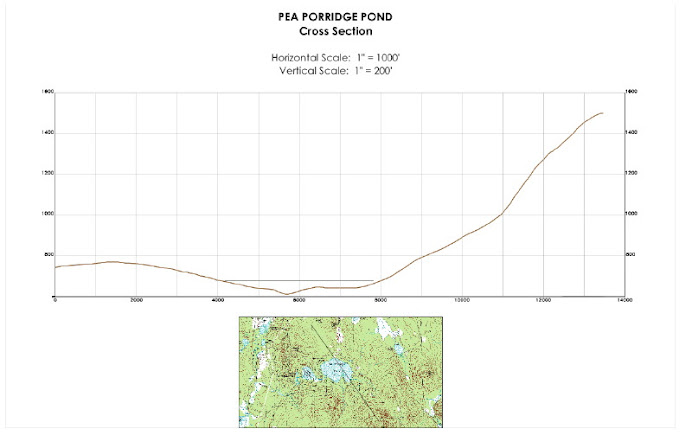Earlier, we posted a temperature-dissolved oxygen profile for Big Pea Porridge Pond taken March 30, 2008. Its purpose was to show:
1) the winter temperature profile, with densest (4 C) water filling the lake bottom and underlying colder (therefore less dense) water beneath the ice-covered surface. With less dense water "capping off" more dense deep water, the water column is stabilized, i.e., little vertical mixing or replenishment of deep waters occurs in winter. Also, ice cover prevents wind (the major force behind lake water mixing) from accessing the water surface. Winter stagnation of the column results.
2) the dissolved oxygen curve dropping off with depth. Loss of oxygen in deeper waters is primarily the result of the bacterial/fungal decomposition of organic (i.e., biologically derived) matter that has sunk to accumulate on the bottom. Without circulation to replenish lost oxygen, the extent of oxygen loss is a rough measure of how much organic matter is produced in the lake – in other words, its level of productivity.
As warmth returns in spring and the ice melts, the < 4 C surface waters heat up to match the 4 C deep waters. At that point, temperatures and therefore density of waters within the entire water column are equal. As a result, the water column loses its "stability". As the wind blows across surface waters, pushing them toward the leeward side of the lake, surface waters are driven downward, while elsewhere in matching volume, the lake deep waters are forced to the surface. This creates a "turnover" during which the water column becomes uniformly mixed. Temperatures and dissolved oxygen levels (replenished as oxygen-stripped deeper waters mix to the surface and make atmospheric contact) are equal top to bottom.
This process is the "spring turnover". Full lake vertical mixing like this returns to sun-lit surface waters the nutrients that were freed during the winter as decomposers worked over the organic matter there. These vital nutrients were trapped until the turnover by the stagnant winter water column. With sunlight and nutrients finally available in surface waters, the single-celled and colonial phytoplankton (the plant component of the plankton community – algae, diatoms, dinoflagellates, bluegreen bacteria, etc.) – can surge into photosynthetic action, producing a peak in lake's annual productivity known as the "spring bloom".
The graph below shows the temperature-dissolved oxygen profile observed on May 9, 2008 at the "deep spot" in Big Pea Porridge Pond. If you tip your head 90 degrees to the left, you can see the results from top (left) to bottom. As you will see, we missed catching the turn-over period exactly. While the water column is still pretty uniform with regard to dissolved oxygen levels, the temperature profile is no longer uniform. Understandably, the top 3 meters of surface waters are capturing more heat than deeper waters. By doing that, the warming surface waters, referred to as the "epilimnion", are also becoming progressive less dense than the deeper, cold waters of the "hypolimnion". (There is an inverse relationship between temperature and density – the higher the temperature, the lower the density of water). The intermediate zone including the steep temperature gradient separating these two layers, e.g., between 2-3 meters on this graph, forms the "metalimnion" or "thermocline". As the temperature-density contrast builds between epilimnion and hypolimnion waters, the stability of the water column builds. Deeper, colder, denser waters resist wind-driven vertical mixing of warmed surface waters. The whole lake is no longer involved in mixing – just the wind-driven, warmer epilimnion waters continue to circulate. As the vertical depth of mixing becomes more limited, lower-density, surface epilimnion waters become warmer and warmer, and the stability of the water column increases. This leads to a summer-time stratification/stagnation of the water column that isolates deep, darker, colder hypolimnion from the sunny, warm low density epilimnion. The buildup of the summer temperature stratification will be the subject of our next temperature-dissolved oxygen profile later on in the season.

Lee


